Organisational Behaviour Report: Leadership and Management at TESCO
VerifiedAdded on 2021/02/19
|13
|3473
|20
Report
AI Summary
This report provides a comprehensive analysis of organisational behaviour, focusing on the multinational retail giant, TESCO. It begins with an introduction to organisational behaviour, its key levels, and the selection of TESCO as a case study. The report then delves into leadership theories such as path-goal, transactional, and trait theories, evaluating their application within TESCO. It examines the impact of different managerial styles on organisational effectiveness and explores motivational theories, including the carrot and stick theory and Vroom's expectancy theory, to inform employee motivation strategies. The report also analyzes theories related to work relationships and interactions, such as social exchange theory and uncertainty reduction theory, illustrating their relevance to TESCO's operations. Furthermore, the report investigates TESCO's organisational structure and culture, including person, power, role, and task cultures, and assesses their impact on the company's effectiveness. Finally, it analyzes various approaches to organisational decision-making, including the rational approach, and examines management strategies for handling uncertainty and risk, concluding with an evaluation of the effectiveness of organisational decisions within TESCO. The report concludes with a summary of findings and references used.
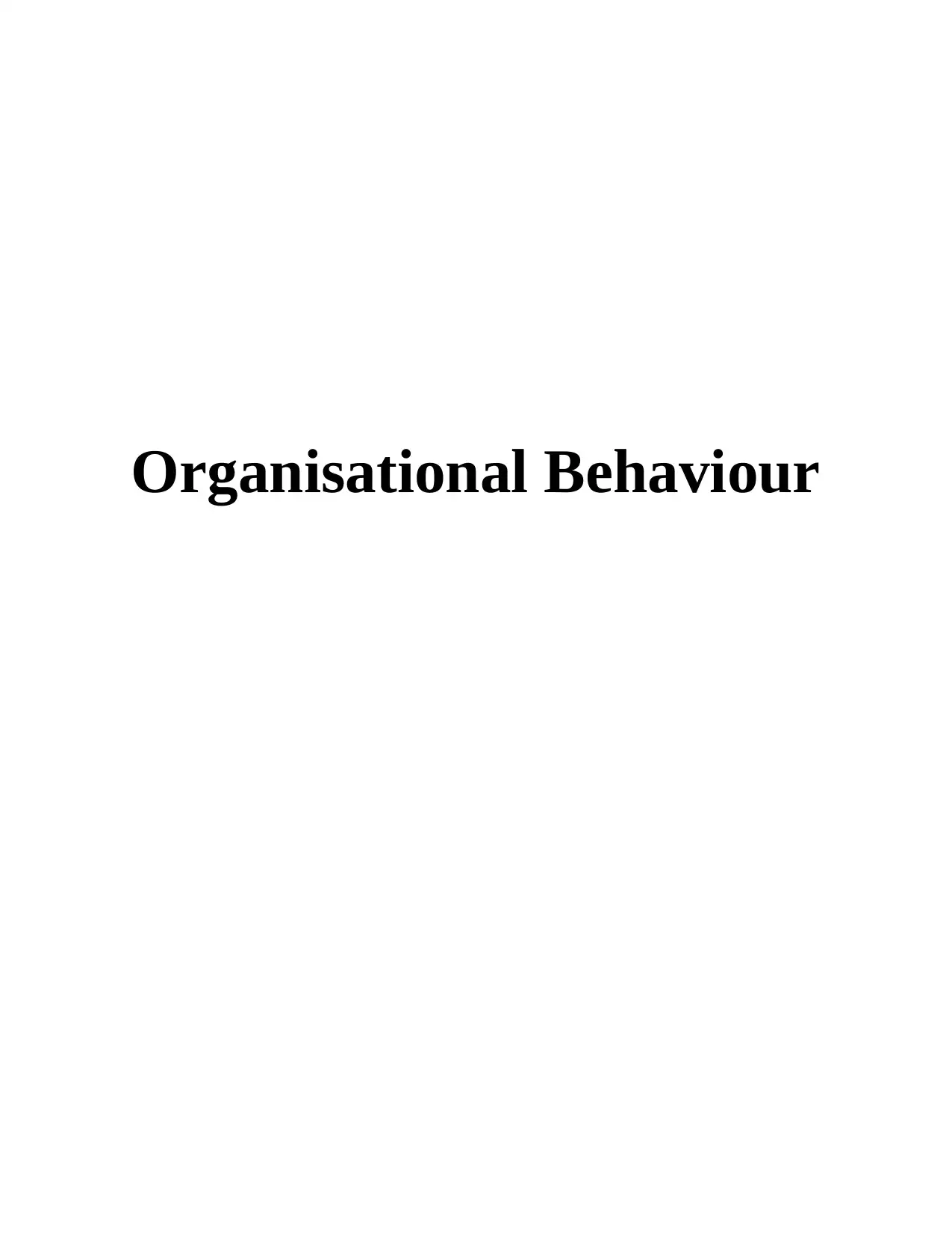
Organisational Behaviour
Paraphrase This Document
Need a fresh take? Get an instant paraphrase of this document with our AI Paraphraser
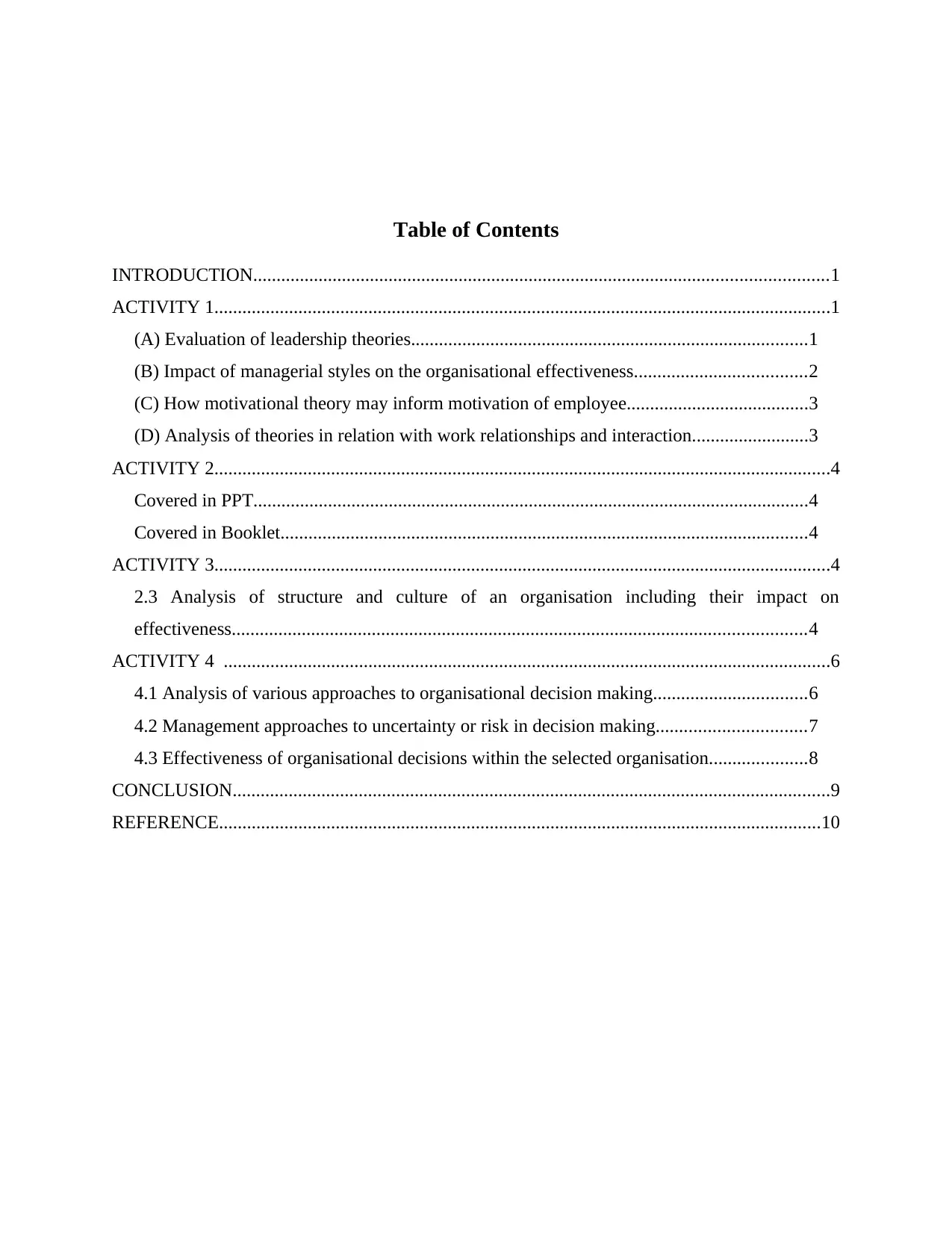
Table of Contents
INTRODUCTION...........................................................................................................................1
ACTIVITY 1....................................................................................................................................1
(A) Evaluation of leadership theories.....................................................................................1
(B) Impact of managerial styles on the organisational effectiveness.....................................2
(C) How motivational theory may inform motivation of employee.......................................3
(D) Analysis of theories in relation with work relationships and interaction.........................3
ACTIVITY 2....................................................................................................................................4
Covered in PPT.......................................................................................................................4
Covered in Booklet.................................................................................................................4
ACTIVITY 3....................................................................................................................................4
2.3 Analysis of structure and culture of an organisation including their impact on
effectiveness...........................................................................................................................4
ACTIVITY 4 ..................................................................................................................................6
4.1 Analysis of various approaches to organisational decision making.................................6
4.2 Management approaches to uncertainty or risk in decision making................................7
4.3 Effectiveness of organisational decisions within the selected organisation.....................8
CONCLUSION................................................................................................................................9
REFERENCE.................................................................................................................................10
INTRODUCTION...........................................................................................................................1
ACTIVITY 1....................................................................................................................................1
(A) Evaluation of leadership theories.....................................................................................1
(B) Impact of managerial styles on the organisational effectiveness.....................................2
(C) How motivational theory may inform motivation of employee.......................................3
(D) Analysis of theories in relation with work relationships and interaction.........................3
ACTIVITY 2....................................................................................................................................4
Covered in PPT.......................................................................................................................4
Covered in Booklet.................................................................................................................4
ACTIVITY 3....................................................................................................................................4
2.3 Analysis of structure and culture of an organisation including their impact on
effectiveness...........................................................................................................................4
ACTIVITY 4 ..................................................................................................................................6
4.1 Analysis of various approaches to organisational decision making.................................6
4.2 Management approaches to uncertainty or risk in decision making................................7
4.3 Effectiveness of organisational decisions within the selected organisation.....................8
CONCLUSION................................................................................................................................9
REFERENCE.................................................................................................................................10

⊘ This is a preview!⊘
Do you want full access?
Subscribe today to unlock all pages.

Trusted by 1+ million students worldwide
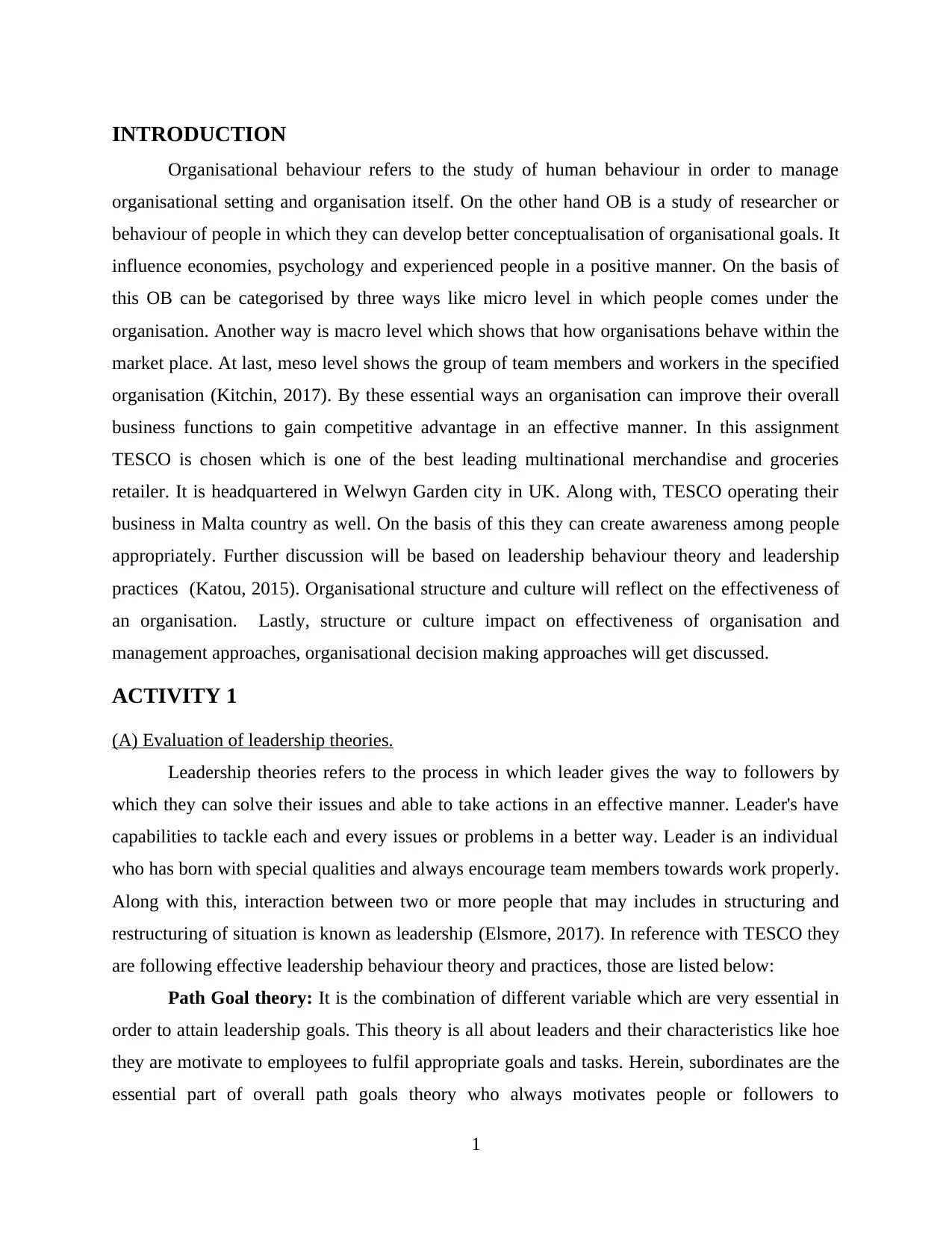
INTRODUCTION
Organisational behaviour refers to the study of human behaviour in order to manage
organisational setting and organisation itself. On the other hand OB is a study of researcher or
behaviour of people in which they can develop better conceptualisation of organisational goals. It
influence economies, psychology and experienced people in a positive manner. On the basis of
this OB can be categorised by three ways like micro level in which people comes under the
organisation. Another way is macro level which shows that how organisations behave within the
market place. At last, meso level shows the group of team members and workers in the specified
organisation (Kitchin, 2017). By these essential ways an organisation can improve their overall
business functions to gain competitive advantage in an effective manner. In this assignment
TESCO is chosen which is one of the best leading multinational merchandise and groceries
retailer. It is headquartered in Welwyn Garden city in UK. Along with, TESCO operating their
business in Malta country as well. On the basis of this they can create awareness among people
appropriately. Further discussion will be based on leadership behaviour theory and leadership
practices (Katou, 2015). Organisational structure and culture will reflect on the effectiveness of
an organisation. Lastly, structure or culture impact on effectiveness of organisation and
management approaches, organisational decision making approaches will get discussed.
ACTIVITY 1
(A) Evaluation of leadership theories.
Leadership theories refers to the process in which leader gives the way to followers by
which they can solve their issues and able to take actions in an effective manner. Leader's have
capabilities to tackle each and every issues or problems in a better way. Leader is an individual
who has born with special qualities and always encourage team members towards work properly.
Along with this, interaction between two or more people that may includes in structuring and
restructuring of situation is known as leadership (Elsmore, 2017). In reference with TESCO they
are following effective leadership behaviour theory and practices, those are listed below:
Path Goal theory: It is the combination of different variable which are very essential in
order to attain leadership goals. This theory is all about leaders and their characteristics like hoe
they are motivate to employees to fulfil appropriate goals and tasks. Herein, subordinates are the
essential part of overall path goals theory who always motivates people or followers to
1
Organisational behaviour refers to the study of human behaviour in order to manage
organisational setting and organisation itself. On the other hand OB is a study of researcher or
behaviour of people in which they can develop better conceptualisation of organisational goals. It
influence economies, psychology and experienced people in a positive manner. On the basis of
this OB can be categorised by three ways like micro level in which people comes under the
organisation. Another way is macro level which shows that how organisations behave within the
market place. At last, meso level shows the group of team members and workers in the specified
organisation (Kitchin, 2017). By these essential ways an organisation can improve their overall
business functions to gain competitive advantage in an effective manner. In this assignment
TESCO is chosen which is one of the best leading multinational merchandise and groceries
retailer. It is headquartered in Welwyn Garden city in UK. Along with, TESCO operating their
business in Malta country as well. On the basis of this they can create awareness among people
appropriately. Further discussion will be based on leadership behaviour theory and leadership
practices (Katou, 2015). Organisational structure and culture will reflect on the effectiveness of
an organisation. Lastly, structure or culture impact on effectiveness of organisation and
management approaches, organisational decision making approaches will get discussed.
ACTIVITY 1
(A) Evaluation of leadership theories.
Leadership theories refers to the process in which leader gives the way to followers by
which they can solve their issues and able to take actions in an effective manner. Leader's have
capabilities to tackle each and every issues or problems in a better way. Leader is an individual
who has born with special qualities and always encourage team members towards work properly.
Along with this, interaction between two or more people that may includes in structuring and
restructuring of situation is known as leadership (Elsmore, 2017). In reference with TESCO they
are following effective leadership behaviour theory and practices, those are listed below:
Path Goal theory: It is the combination of different variable which are very essential in
order to attain leadership goals. This theory is all about leaders and their characteristics like hoe
they are motivate to employees to fulfil appropriate goals and tasks. Herein, subordinates are the
essential part of overall path goals theory who always motivates people or followers to
1
Paraphrase This Document
Need a fresh take? Get an instant paraphrase of this document with our AI Paraphraser
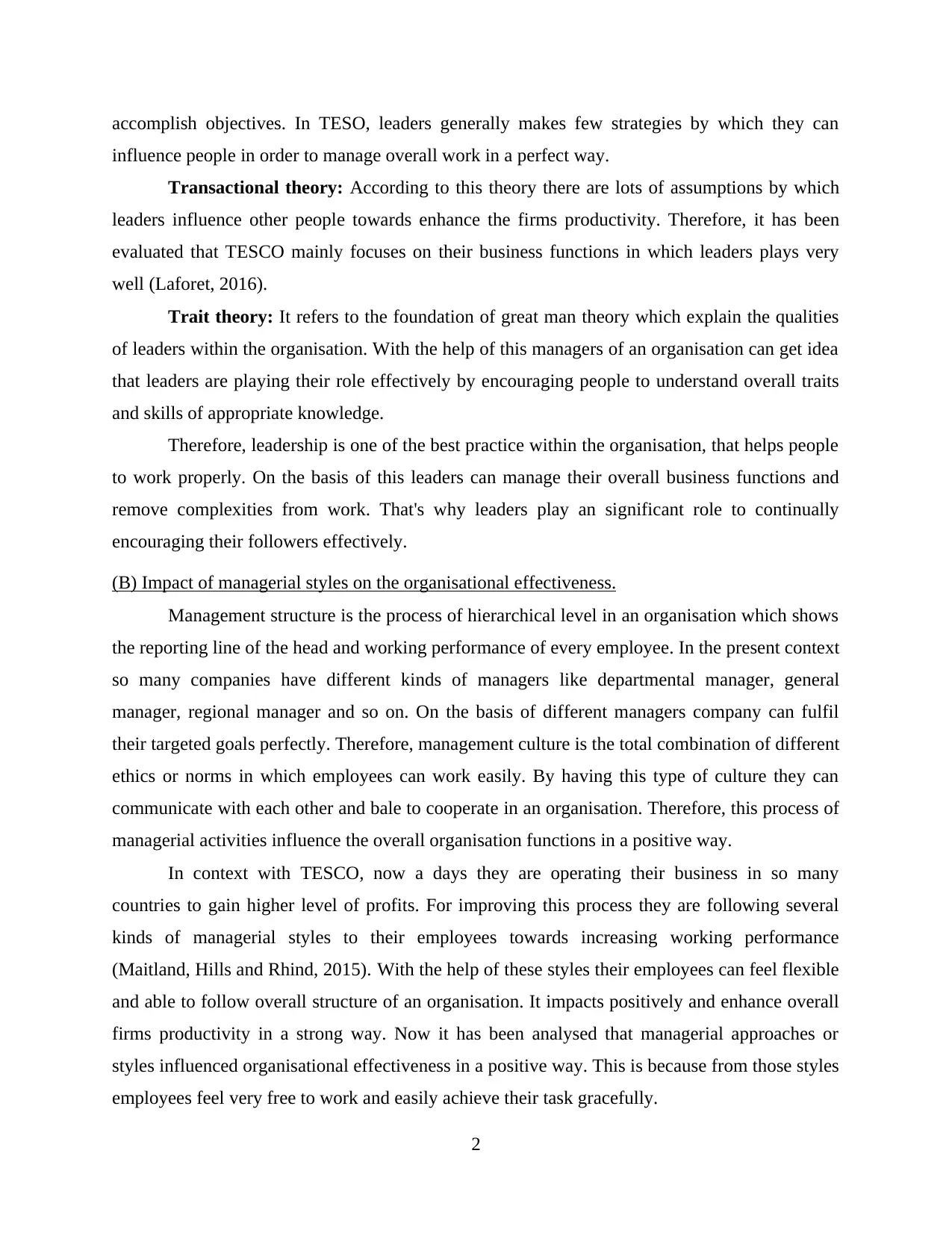
accomplish objectives. In TESO, leaders generally makes few strategies by which they can
influence people in order to manage overall work in a perfect way.
Transactional theory: According to this theory there are lots of assumptions by which
leaders influence other people towards enhance the firms productivity. Therefore, it has been
evaluated that TESCO mainly focuses on their business functions in which leaders plays very
well (Laforet, 2016).
Trait theory: It refers to the foundation of great man theory which explain the qualities
of leaders within the organisation. With the help of this managers of an organisation can get idea
that leaders are playing their role effectively by encouraging people to understand overall traits
and skills of appropriate knowledge.
Therefore, leadership is one of the best practice within the organisation, that helps people
to work properly. On the basis of this leaders can manage their overall business functions and
remove complexities from work. That's why leaders play an significant role to continually
encouraging their followers effectively.
(B) Impact of managerial styles on the organisational effectiveness.
Management structure is the process of hierarchical level in an organisation which shows
the reporting line of the head and working performance of every employee. In the present context
so many companies have different kinds of managers like departmental manager, general
manager, regional manager and so on. On the basis of different managers company can fulfil
their targeted goals perfectly. Therefore, management culture is the total combination of different
ethics or norms in which employees can work easily. By having this type of culture they can
communicate with each other and bale to cooperate in an organisation. Therefore, this process of
managerial activities influence the overall organisation functions in a positive way.
In context with TESCO, now a days they are operating their business in so many
countries to gain higher level of profits. For improving this process they are following several
kinds of managerial styles to their employees towards increasing working performance
(Maitland, Hills and Rhind, 2015). With the help of these styles their employees can feel flexible
and able to follow overall structure of an organisation. It impacts positively and enhance overall
firms productivity in a strong way. Now it has been analysed that managerial approaches or
styles influenced organisational effectiveness in a positive way. This is because from those styles
employees feel very free to work and easily achieve their task gracefully.
2
influence people in order to manage overall work in a perfect way.
Transactional theory: According to this theory there are lots of assumptions by which
leaders influence other people towards enhance the firms productivity. Therefore, it has been
evaluated that TESCO mainly focuses on their business functions in which leaders plays very
well (Laforet, 2016).
Trait theory: It refers to the foundation of great man theory which explain the qualities
of leaders within the organisation. With the help of this managers of an organisation can get idea
that leaders are playing their role effectively by encouraging people to understand overall traits
and skills of appropriate knowledge.
Therefore, leadership is one of the best practice within the organisation, that helps people
to work properly. On the basis of this leaders can manage their overall business functions and
remove complexities from work. That's why leaders play an significant role to continually
encouraging their followers effectively.
(B) Impact of managerial styles on the organisational effectiveness.
Management structure is the process of hierarchical level in an organisation which shows
the reporting line of the head and working performance of every employee. In the present context
so many companies have different kinds of managers like departmental manager, general
manager, regional manager and so on. On the basis of different managers company can fulfil
their targeted goals perfectly. Therefore, management culture is the total combination of different
ethics or norms in which employees can work easily. By having this type of culture they can
communicate with each other and bale to cooperate in an organisation. Therefore, this process of
managerial activities influence the overall organisation functions in a positive way.
In context with TESCO, now a days they are operating their business in so many
countries to gain higher level of profits. For improving this process they are following several
kinds of managerial styles to their employees towards increasing working performance
(Maitland, Hills and Rhind, 2015). With the help of these styles their employees can feel flexible
and able to follow overall structure of an organisation. It impacts positively and enhance overall
firms productivity in a strong way. Now it has been analysed that managerial approaches or
styles influenced organisational effectiveness in a positive way. This is because from those styles
employees feel very free to work and easily achieve their task gracefully.
2
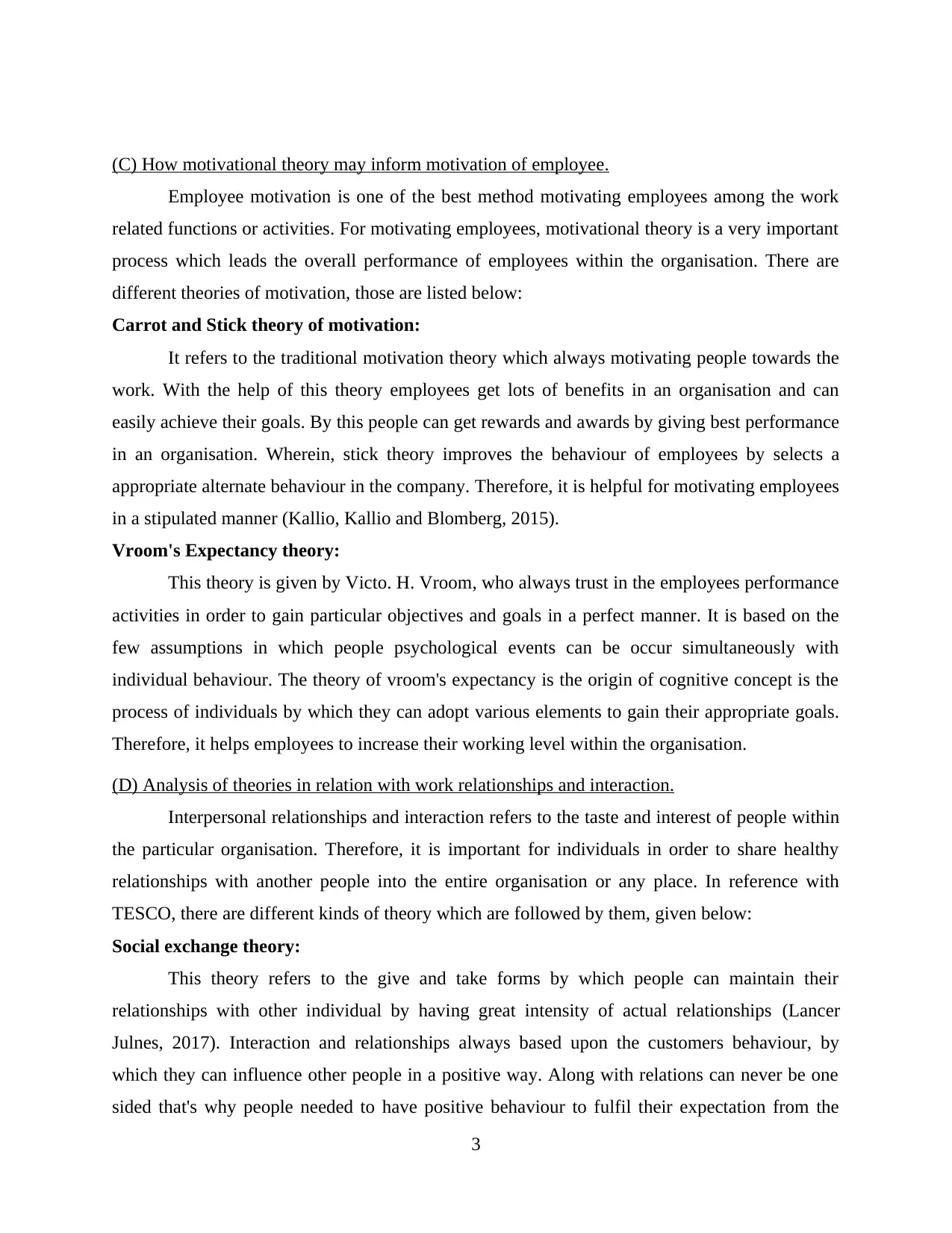
(C) How motivational theory may inform motivation of employee.
Employee motivation is one of the best method motivating employees among the work
related functions or activities. For motivating employees, motivational theory is a very important
process which leads the overall performance of employees within the organisation. There are
different theories of motivation, those are listed below:
Carrot and Stick theory of motivation:
It refers to the traditional motivation theory which always motivating people towards the
work. With the help of this theory employees get lots of benefits in an organisation and can
easily achieve their goals. By this people can get rewards and awards by giving best performance
in an organisation. Wherein, stick theory improves the behaviour of employees by selects a
appropriate alternate behaviour in the company. Therefore, it is helpful for motivating employees
in a stipulated manner (Kallio, Kallio and Blomberg, 2015).
Vroom's Expectancy theory:
This theory is given by Victo. H. Vroom, who always trust in the employees performance
activities in order to gain particular objectives and goals in a perfect manner. It is based on the
few assumptions in which people psychological events can be occur simultaneously with
individual behaviour. The theory of vroom's expectancy is the origin of cognitive concept is the
process of individuals by which they can adopt various elements to gain their appropriate goals.
Therefore, it helps employees to increase their working level within the organisation.
(D) Analysis of theories in relation with work relationships and interaction.
Interpersonal relationships and interaction refers to the taste and interest of people within
the particular organisation. Therefore, it is important for individuals in order to share healthy
relationships with another people into the entire organisation or any place. In reference with
TESCO, there are different kinds of theory which are followed by them, given below:
Social exchange theory:
This theory refers to the give and take forms by which people can maintain their
relationships with other individual by having great intensity of actual relationships (Lancer
Julnes, 2017). Interaction and relationships always based upon the customers behaviour, by
which they can influence other people in a positive way. Along with relations can never be one
sided that's why people needed to have positive behaviour to fulfil their expectation from the
3
Employee motivation is one of the best method motivating employees among the work
related functions or activities. For motivating employees, motivational theory is a very important
process which leads the overall performance of employees within the organisation. There are
different theories of motivation, those are listed below:
Carrot and Stick theory of motivation:
It refers to the traditional motivation theory which always motivating people towards the
work. With the help of this theory employees get lots of benefits in an organisation and can
easily achieve their goals. By this people can get rewards and awards by giving best performance
in an organisation. Wherein, stick theory improves the behaviour of employees by selects a
appropriate alternate behaviour in the company. Therefore, it is helpful for motivating employees
in a stipulated manner (Kallio, Kallio and Blomberg, 2015).
Vroom's Expectancy theory:
This theory is given by Victo. H. Vroom, who always trust in the employees performance
activities in order to gain particular objectives and goals in a perfect manner. It is based on the
few assumptions in which people psychological events can be occur simultaneously with
individual behaviour. The theory of vroom's expectancy is the origin of cognitive concept is the
process of individuals by which they can adopt various elements to gain their appropriate goals.
Therefore, it helps employees to increase their working level within the organisation.
(D) Analysis of theories in relation with work relationships and interaction.
Interpersonal relationships and interaction refers to the taste and interest of people within
the particular organisation. Therefore, it is important for individuals in order to share healthy
relationships with another people into the entire organisation or any place. In reference with
TESCO, there are different kinds of theory which are followed by them, given below:
Social exchange theory:
This theory refers to the give and take forms by which people can maintain their
relationships with other individual by having great intensity of actual relationships (Lancer
Julnes, 2017). Interaction and relationships always based upon the customers behaviour, by
which they can influence other people in a positive way. Along with relations can never be one
sided that's why people needed to have positive behaviour to fulfil their expectation from the
3
⊘ This is a preview!⊘
Do you want full access?
Subscribe today to unlock all pages.

Trusted by 1+ million students worldwide
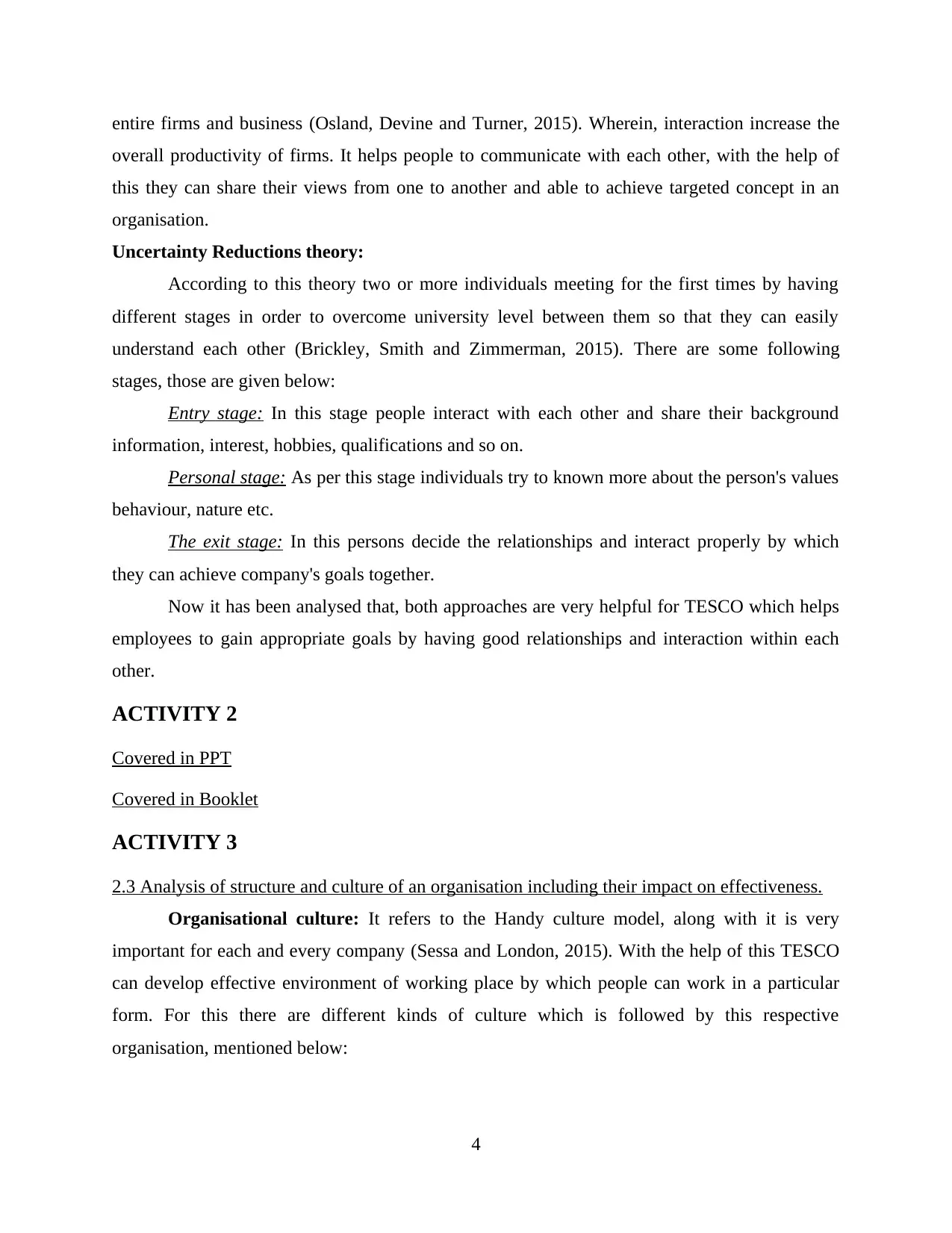
entire firms and business (Osland, Devine and Turner, 2015). Wherein, interaction increase the
overall productivity of firms. It helps people to communicate with each other, with the help of
this they can share their views from one to another and able to achieve targeted concept in an
organisation.
Uncertainty Reductions theory:
According to this theory two or more individuals meeting for the first times by having
different stages in order to overcome university level between them so that they can easily
understand each other (Brickley, Smith and Zimmerman, 2015). There are some following
stages, those are given below:
Entry stage: In this stage people interact with each other and share their background
information, interest, hobbies, qualifications and so on.
Personal stage: As per this stage individuals try to known more about the person's values
behaviour, nature etc.
The exit stage: In this persons decide the relationships and interact properly by which
they can achieve company's goals together.
Now it has been analysed that, both approaches are very helpful for TESCO which helps
employees to gain appropriate goals by having good relationships and interaction within each
other.
ACTIVITY 2
Covered in PPT
Covered in Booklet
ACTIVITY 3
2.3 Analysis of structure and culture of an organisation including their impact on effectiveness.
Organisational culture: It refers to the Handy culture model, along with it is very
important for each and every company (Sessa and London, 2015). With the help of this TESCO
can develop effective environment of working place by which people can work in a particular
form. For this there are different kinds of culture which is followed by this respective
organisation, mentioned below:
4
overall productivity of firms. It helps people to communicate with each other, with the help of
this they can share their views from one to another and able to achieve targeted concept in an
organisation.
Uncertainty Reductions theory:
According to this theory two or more individuals meeting for the first times by having
different stages in order to overcome university level between them so that they can easily
understand each other (Brickley, Smith and Zimmerman, 2015). There are some following
stages, those are given below:
Entry stage: In this stage people interact with each other and share their background
information, interest, hobbies, qualifications and so on.
Personal stage: As per this stage individuals try to known more about the person's values
behaviour, nature etc.
The exit stage: In this persons decide the relationships and interact properly by which
they can achieve company's goals together.
Now it has been analysed that, both approaches are very helpful for TESCO which helps
employees to gain appropriate goals by having good relationships and interaction within each
other.
ACTIVITY 2
Covered in PPT
Covered in Booklet
ACTIVITY 3
2.3 Analysis of structure and culture of an organisation including their impact on effectiveness.
Organisational culture: It refers to the Handy culture model, along with it is very
important for each and every company (Sessa and London, 2015). With the help of this TESCO
can develop effective environment of working place by which people can work in a particular
form. For this there are different kinds of culture which is followed by this respective
organisation, mentioned below:
4
Paraphrase This Document
Need a fresh take? Get an instant paraphrase of this document with our AI Paraphraser
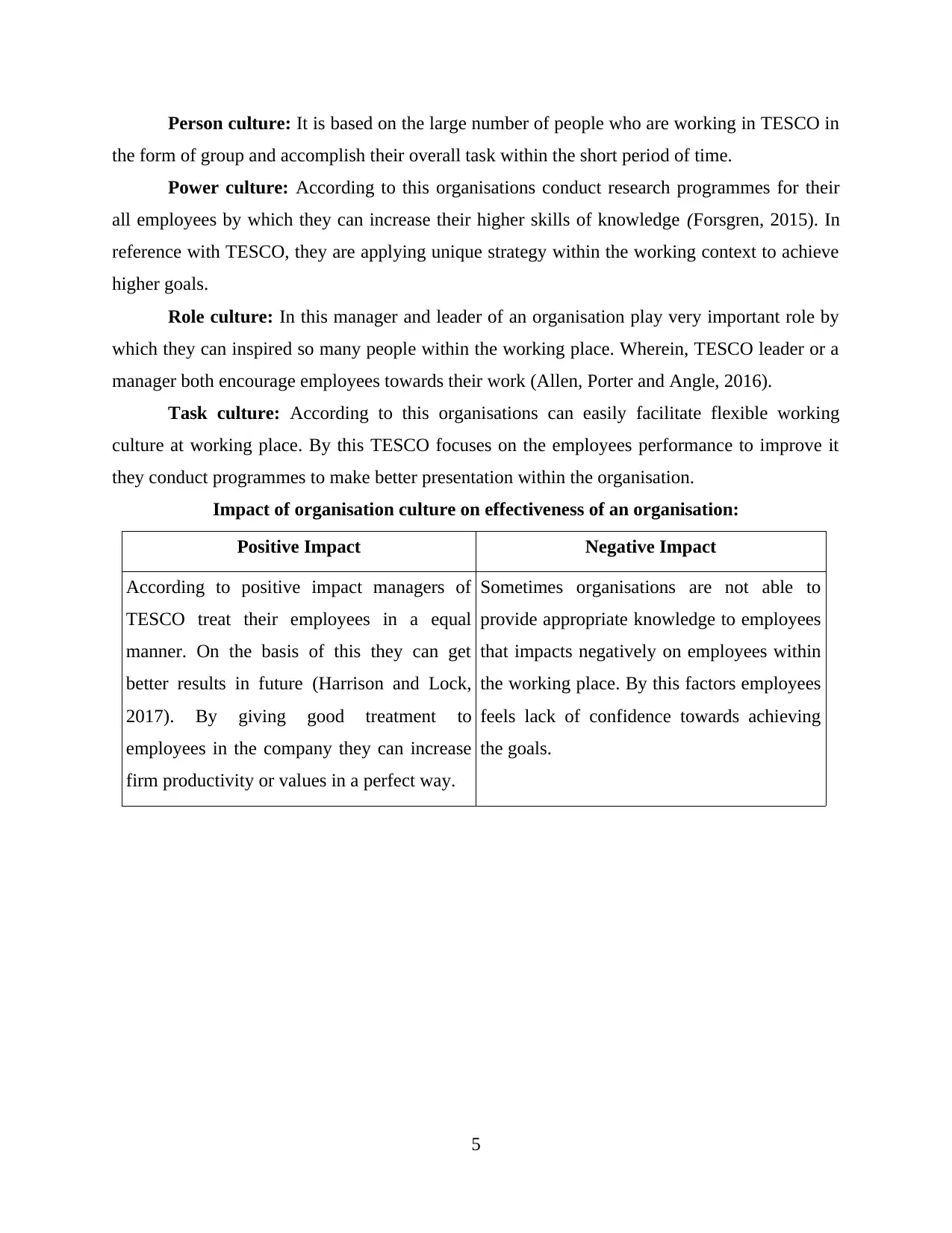
Person culture: It is based on the large number of people who are working in TESCO in
the form of group and accomplish their overall task within the short period of time.
Power culture: According to this organisations conduct research programmes for their
all employees by which they can increase their higher skills of knowledge (Forsgren, 2015). In
reference with TESCO, they are applying unique strategy within the working context to achieve
higher goals.
Role culture: In this manager and leader of an organisation play very important role by
which they can inspired so many people within the working place. Wherein, TESCO leader or a
manager both encourage employees towards their work (Allen, Porter and Angle, 2016).
Task culture: According to this organisations can easily facilitate flexible working
culture at working place. By this TESCO focuses on the employees performance to improve it
they conduct programmes to make better presentation within the organisation.
Impact of organisation culture on effectiveness of an organisation:
Positive Impact Negative Impact
According to positive impact managers of
TESCO treat their employees in a equal
manner. On the basis of this they can get
better results in future (Harrison and Lock,
2017). By giving good treatment to
employees in the company they can increase
firm productivity or values in a perfect way.
Sometimes organisations are not able to
provide appropriate knowledge to employees
that impacts negatively on employees within
the working place. By this factors employees
feels lack of confidence towards achieving
the goals.
5
the form of group and accomplish their overall task within the short period of time.
Power culture: According to this organisations conduct research programmes for their
all employees by which they can increase their higher skills of knowledge (Forsgren, 2015). In
reference with TESCO, they are applying unique strategy within the working context to achieve
higher goals.
Role culture: In this manager and leader of an organisation play very important role by
which they can inspired so many people within the working place. Wherein, TESCO leader or a
manager both encourage employees towards their work (Allen, Porter and Angle, 2016).
Task culture: According to this organisations can easily facilitate flexible working
culture at working place. By this TESCO focuses on the employees performance to improve it
they conduct programmes to make better presentation within the organisation.
Impact of organisation culture on effectiveness of an organisation:
Positive Impact Negative Impact
According to positive impact managers of
TESCO treat their employees in a equal
manner. On the basis of this they can get
better results in future (Harrison and Lock,
2017). By giving good treatment to
employees in the company they can increase
firm productivity or values in a perfect way.
Sometimes organisations are not able to
provide appropriate knowledge to employees
that impacts negatively on employees within
the working place. By this factors employees
feels lack of confidence towards achieving
the goals.
5
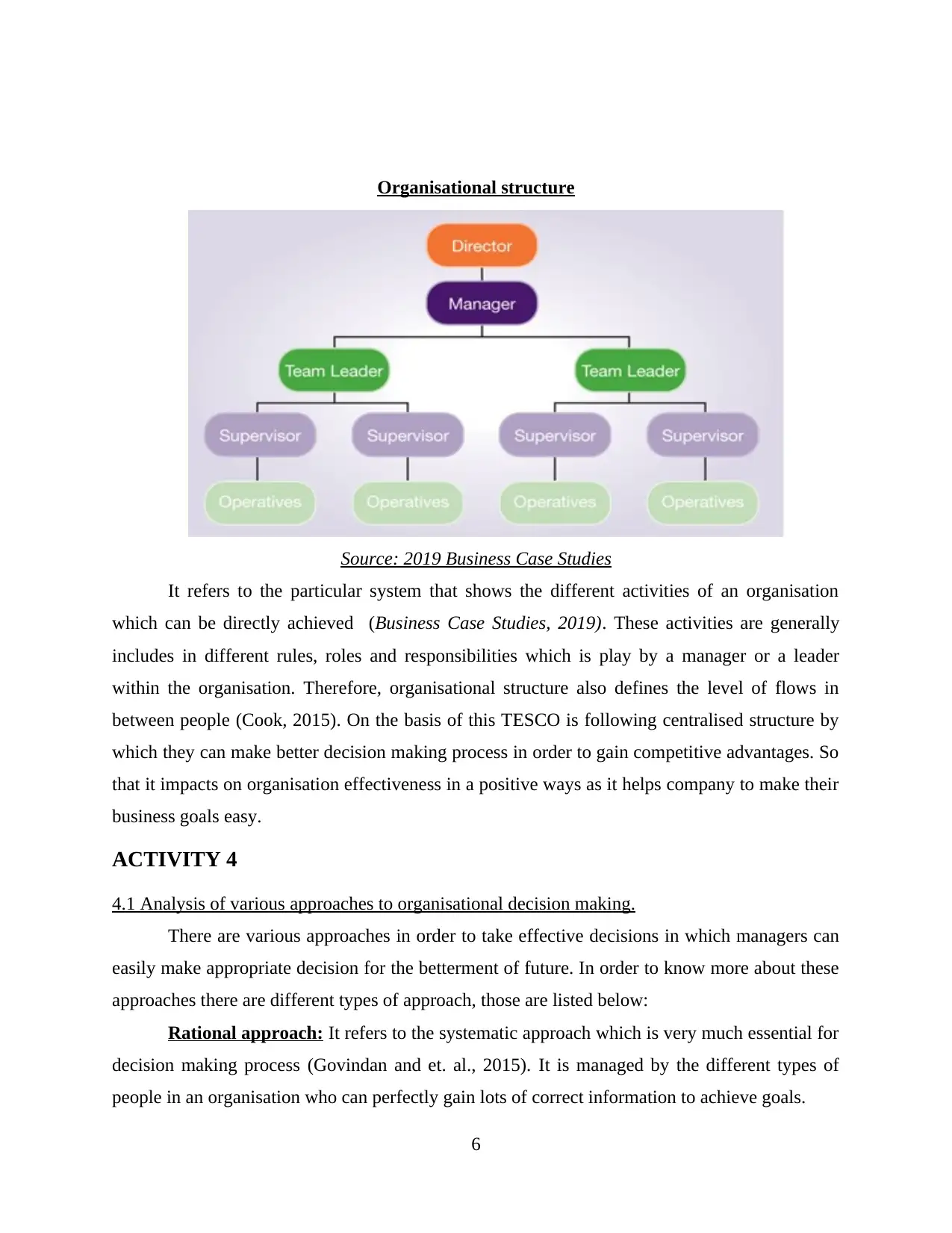
Organisational structure
Source: 2019 Business Case Studies
It refers to the particular system that shows the different activities of an organisation
which can be directly achieved (Business Case Studies, 2019). These activities are generally
includes in different rules, roles and responsibilities which is play by a manager or a leader
within the organisation. Therefore, organisational structure also defines the level of flows in
between people (Cook, 2015). On the basis of this TESCO is following centralised structure by
which they can make better decision making process in order to gain competitive advantages. So
that it impacts on organisation effectiveness in a positive ways as it helps company to make their
business goals easy.
ACTIVITY 4
4.1 Analysis of various approaches to organisational decision making.
There are various approaches in order to take effective decisions in which managers can
easily make appropriate decision for the betterment of future. In order to know more about these
approaches there are different types of approach, those are listed below:
Rational approach: It refers to the systematic approach which is very much essential for
decision making process (Govindan and et. al., 2015). It is managed by the different types of
people in an organisation who can perfectly gain lots of correct information to achieve goals.
6
Source: 2019 Business Case Studies
It refers to the particular system that shows the different activities of an organisation
which can be directly achieved (Business Case Studies, 2019). These activities are generally
includes in different rules, roles and responsibilities which is play by a manager or a leader
within the organisation. Therefore, organisational structure also defines the level of flows in
between people (Cook, 2015). On the basis of this TESCO is following centralised structure by
which they can make better decision making process in order to gain competitive advantages. So
that it impacts on organisation effectiveness in a positive ways as it helps company to make their
business goals easy.
ACTIVITY 4
4.1 Analysis of various approaches to organisational decision making.
There are various approaches in order to take effective decisions in which managers can
easily make appropriate decision for the betterment of future. In order to know more about these
approaches there are different types of approach, those are listed below:
Rational approach: It refers to the systematic approach which is very much essential for
decision making process (Govindan and et. al., 2015). It is managed by the different types of
people in an organisation who can perfectly gain lots of correct information to achieve goals.
6
⊘ This is a preview!⊘
Do you want full access?
Subscribe today to unlock all pages.

Trusted by 1+ million students worldwide
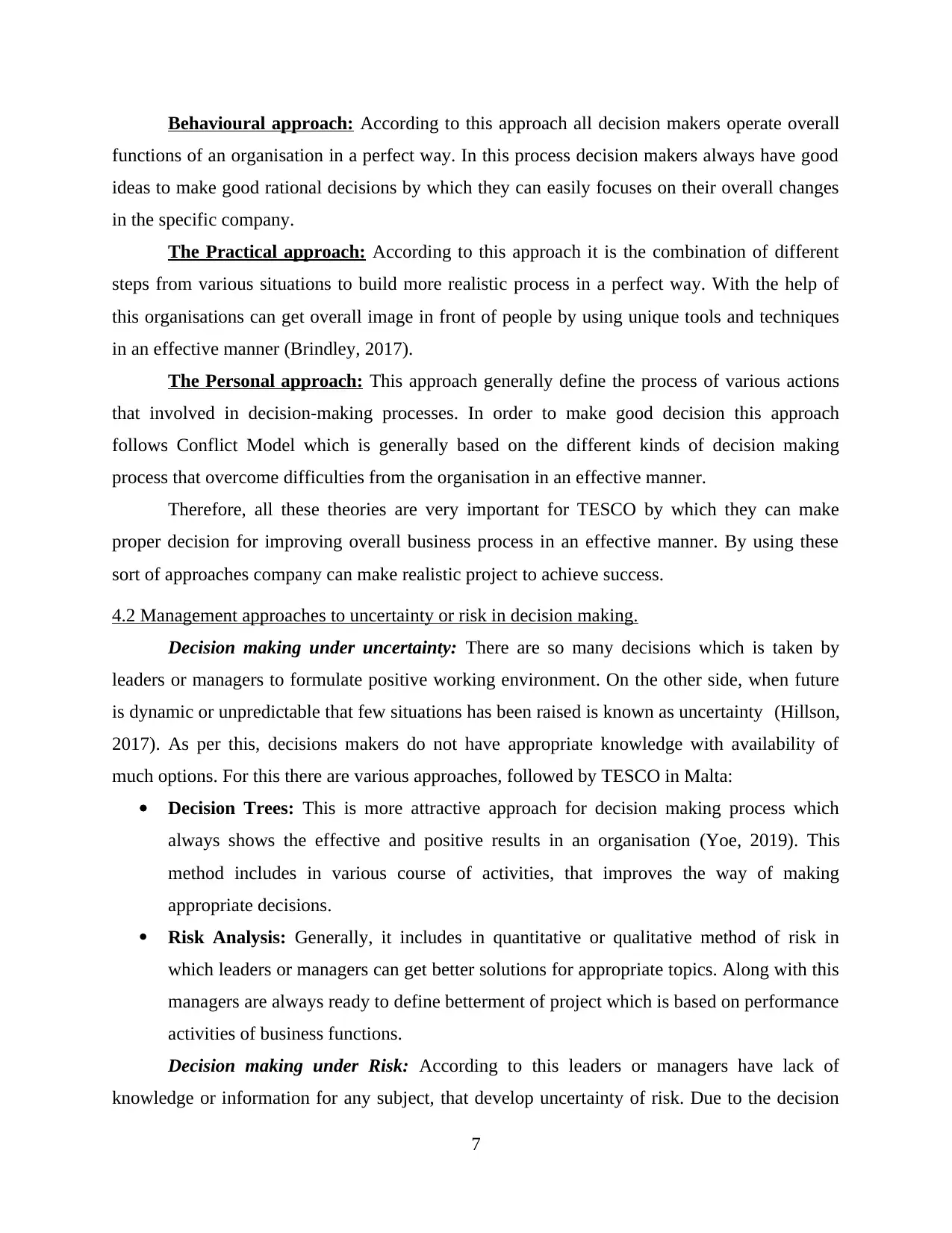
Behavioural approach: According to this approach all decision makers operate overall
functions of an organisation in a perfect way. In this process decision makers always have good
ideas to make good rational decisions by which they can easily focuses on their overall changes
in the specific company.
The Practical approach: According to this approach it is the combination of different
steps from various situations to build more realistic process in a perfect way. With the help of
this organisations can get overall image in front of people by using unique tools and techniques
in an effective manner (Brindley, 2017).
The Personal approach: This approach generally define the process of various actions
that involved in decision-making processes. In order to make good decision this approach
follows Conflict Model which is generally based on the different kinds of decision making
process that overcome difficulties from the organisation in an effective manner.
Therefore, all these theories are very important for TESCO by which they can make
proper decision for improving overall business process in an effective manner. By using these
sort of approaches company can make realistic project to achieve success.
4.2 Management approaches to uncertainty or risk in decision making.
Decision making under uncertainty: There are so many decisions which is taken by
leaders or managers to formulate positive working environment. On the other side, when future
is dynamic or unpredictable that few situations has been raised is known as uncertainty (Hillson,
2017). As per this, decisions makers do not have appropriate knowledge with availability of
much options. For this there are various approaches, followed by TESCO in Malta:
Decision Trees: This is more attractive approach for decision making process which
always shows the effective and positive results in an organisation (Yoe, 2019). This
method includes in various course of activities, that improves the way of making
appropriate decisions.
Risk Analysis: Generally, it includes in quantitative or qualitative method of risk in
which leaders or managers can get better solutions for appropriate topics. Along with this
managers are always ready to define betterment of project which is based on performance
activities of business functions.
Decision making under Risk: According to this leaders or managers have lack of
knowledge or information for any subject, that develop uncertainty of risk. Due to the decision
7
functions of an organisation in a perfect way. In this process decision makers always have good
ideas to make good rational decisions by which they can easily focuses on their overall changes
in the specific company.
The Practical approach: According to this approach it is the combination of different
steps from various situations to build more realistic process in a perfect way. With the help of
this organisations can get overall image in front of people by using unique tools and techniques
in an effective manner (Brindley, 2017).
The Personal approach: This approach generally define the process of various actions
that involved in decision-making processes. In order to make good decision this approach
follows Conflict Model which is generally based on the different kinds of decision making
process that overcome difficulties from the organisation in an effective manner.
Therefore, all these theories are very important for TESCO by which they can make
proper decision for improving overall business process in an effective manner. By using these
sort of approaches company can make realistic project to achieve success.
4.2 Management approaches to uncertainty or risk in decision making.
Decision making under uncertainty: There are so many decisions which is taken by
leaders or managers to formulate positive working environment. On the other side, when future
is dynamic or unpredictable that few situations has been raised is known as uncertainty (Hillson,
2017). As per this, decisions makers do not have appropriate knowledge with availability of
much options. For this there are various approaches, followed by TESCO in Malta:
Decision Trees: This is more attractive approach for decision making process which
always shows the effective and positive results in an organisation (Yoe, 2019). This
method includes in various course of activities, that improves the way of making
appropriate decisions.
Risk Analysis: Generally, it includes in quantitative or qualitative method of risk in
which leaders or managers can get better solutions for appropriate topics. Along with this
managers are always ready to define betterment of project which is based on performance
activities of business functions.
Decision making under Risk: According to this leaders or managers have lack of
knowledge or information for any subject, that develop uncertainty of risk. Due to the decision
7
Paraphrase This Document
Need a fresh take? Get an instant paraphrase of this document with our AI Paraphraser
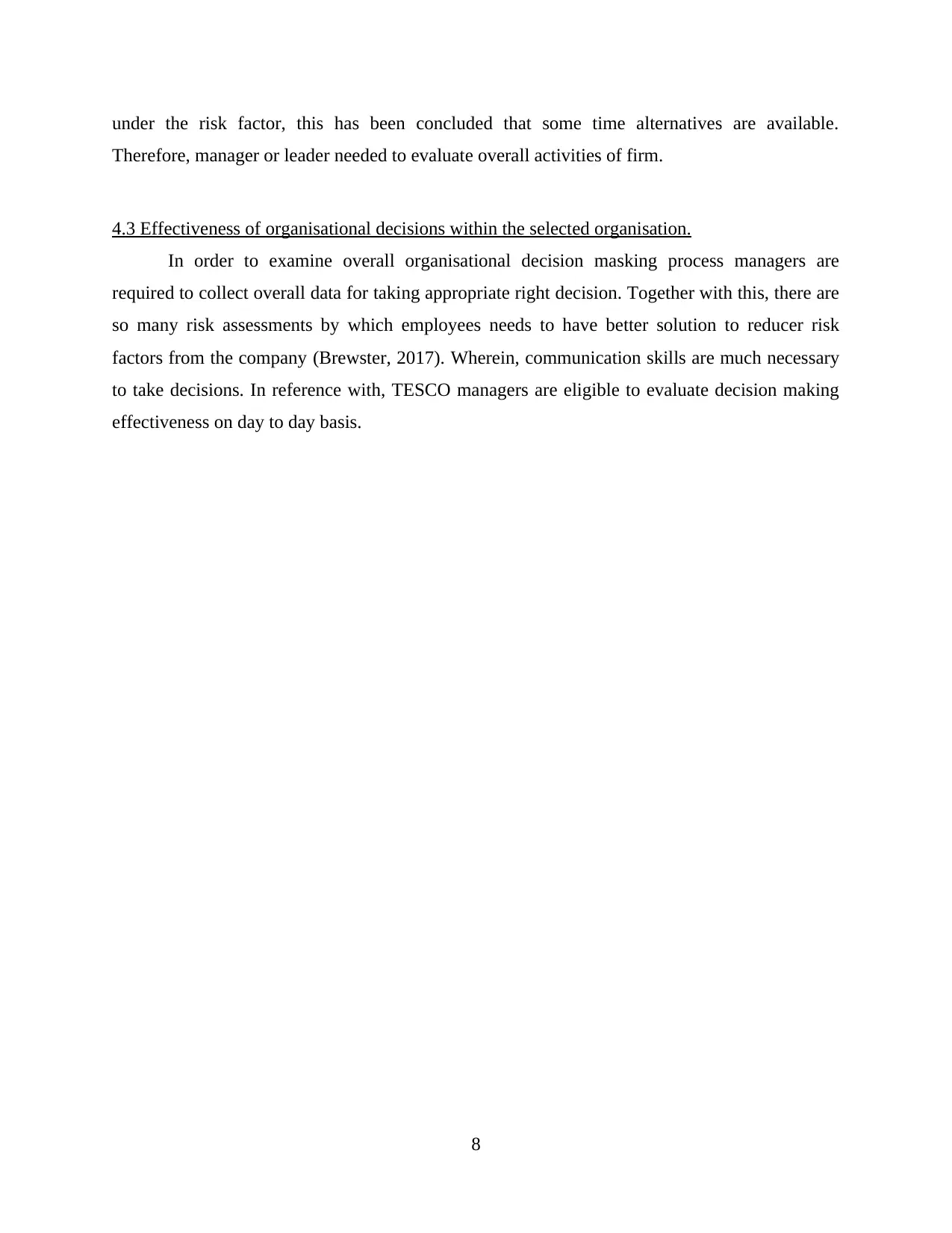
under the risk factor, this has been concluded that some time alternatives are available.
Therefore, manager or leader needed to evaluate overall activities of firm.
4.3 Effectiveness of organisational decisions within the selected organisation.
In order to examine overall organisational decision masking process managers are
required to collect overall data for taking appropriate right decision. Together with this, there are
so many risk assessments by which employees needs to have better solution to reducer risk
factors from the company (Brewster, 2017). Wherein, communication skills are much necessary
to take decisions. In reference with, TESCO managers are eligible to evaluate decision making
effectiveness on day to day basis.
8
Therefore, manager or leader needed to evaluate overall activities of firm.
4.3 Effectiveness of organisational decisions within the selected organisation.
In order to examine overall organisational decision masking process managers are
required to collect overall data for taking appropriate right decision. Together with this, there are
so many risk assessments by which employees needs to have better solution to reducer risk
factors from the company (Brewster, 2017). Wherein, communication skills are much necessary
to take decisions. In reference with, TESCO managers are eligible to evaluate decision making
effectiveness on day to day basis.
8
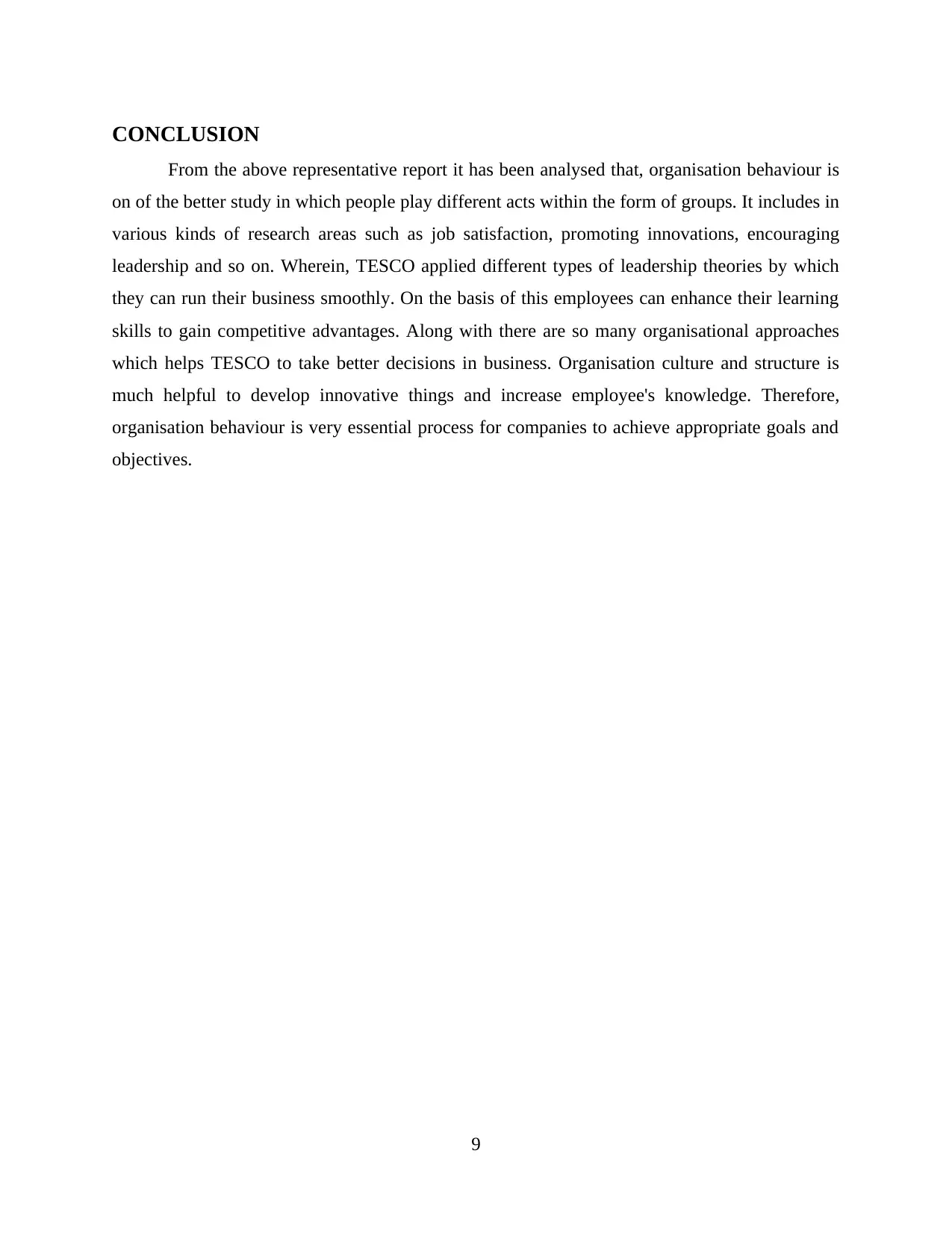
CONCLUSION
From the above representative report it has been analysed that, organisation behaviour is
on of the better study in which people play different acts within the form of groups. It includes in
various kinds of research areas such as job satisfaction, promoting innovations, encouraging
leadership and so on. Wherein, TESCO applied different types of leadership theories by which
they can run their business smoothly. On the basis of this employees can enhance their learning
skills to gain competitive advantages. Along with there are so many organisational approaches
which helps TESCO to take better decisions in business. Organisation culture and structure is
much helpful to develop innovative things and increase employee's knowledge. Therefore,
organisation behaviour is very essential process for companies to achieve appropriate goals and
objectives.
9
From the above representative report it has been analysed that, organisation behaviour is
on of the better study in which people play different acts within the form of groups. It includes in
various kinds of research areas such as job satisfaction, promoting innovations, encouraging
leadership and so on. Wherein, TESCO applied different types of leadership theories by which
they can run their business smoothly. On the basis of this employees can enhance their learning
skills to gain competitive advantages. Along with there are so many organisational approaches
which helps TESCO to take better decisions in business. Organisation culture and structure is
much helpful to develop innovative things and increase employee's knowledge. Therefore,
organisation behaviour is very essential process for companies to achieve appropriate goals and
objectives.
9
⊘ This is a preview!⊘
Do you want full access?
Subscribe today to unlock all pages.

Trusted by 1+ million students worldwide
1 out of 13
Related Documents
Your All-in-One AI-Powered Toolkit for Academic Success.
+13062052269
info@desklib.com
Available 24*7 on WhatsApp / Email
![[object Object]](/_next/static/media/star-bottom.7253800d.svg)
Unlock your academic potential
Copyright © 2020–2025 A2Z Services. All Rights Reserved. Developed and managed by ZUCOL.





